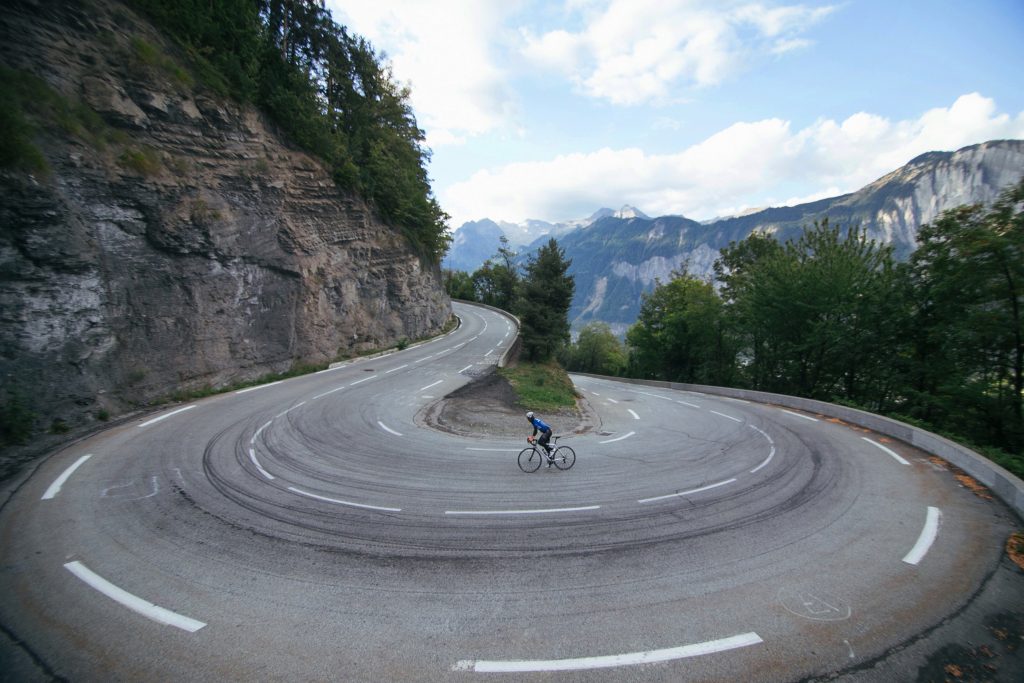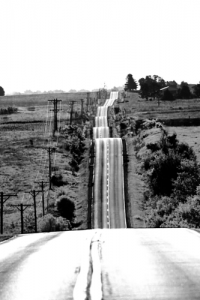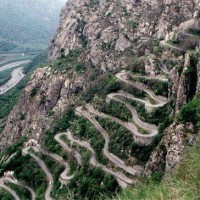From the archives about my 2002 WSSC session on Rolling Hills and Switchbacks.
On one of the indoor cycling forums on Facebook recently, someone asked about the song “What’s Up” by Four Non Blondes. She wanted to know what to do to the song in her cycling class. I started using this song in the early 2000s and have always used it for the same thing…simulating switchbacks on a climb. All that really means is I have the class sit on the verse and stand on the chorus, but how I describe it visually is the difference.
As a master instructor for the Spinning® program, I presented a session at WSSC (World Spinning and Sports Conference) many years ago in which I used the song for switchbacks on a climb. After her Facebook post, I started digging through my files and found my original handout for that presentation from 2002 at WSSC Miami and at WSSC Chicago a few months later. I want to give you that handout here.
Looking at my handout got me thinking about that session and its impact on our industry. Spinning has changed a lot in the last two decades, but at the time of this WSSC in 2002, it was fairly set in its ways. I was a part of the MI crew that helped instigate some important changes to the Spinning program around that time. Prior to that session, all Spinning climbing sessions at conferences followed the protocol of what they call the Strength Energy Zone, or SEZ. Back then, it was basically a class with high resistance and slower cadence (60–80 rpm) the entire time outside of warm-up and cool-down. The working part of the ride was to be held at 75%–85% of max heart rate.
In the early days of Spinning, there was little to no reference to the undulations of hilly rides or switchbacks—I had never heard them in the many sessions I took that were led by my MI peers, and as I look at the session offerings at every single WSSC since they started in 1999, there was no workshop that covered these until my session in 2002. There was also no reference to “downhills” that you can use to propel you up the next hill or to use as a recovery. In fact, at the time, some (including Spinning creator Johnny G) said you can “never ride downhill” in a Spinning class.
My thinking was, you never truly ride uphill either—we’re on a bike that goes nowhere, so if we can visualize climbing uphill, we can also visualize riding downhill. Right? Why not just use that imaginary “downhill” as a recovery? This Rolling Hills and Switchbacks session in 2002 was the first session at WSSC, or any fitness conference for that matter, that touched on how to coach rolling hills and switchbacks in a realistic manner that added excitement and real world application to your indoor classes.
That doesn’t mean that Spinning “Strength” (i.e., climbing) classes weren’t based on real riding—they were, or at least the attempt was to base it on real outdoor climbing (set aside the fact that, yes, you can indeed pedal faster than 80 rpm uphill). It’s just that these climbing terms had not been widely implemented officially. That also does not mean there weren’t instructors out there doing “rolling hills” and “switchbacks” in their classes. If they were avid cyclists, especially those who lived in hilly or mountainous areas, I bet they were—it just hadn’t been done at any conference or workshop level. However, I do remember having to explain over and over at conferences and in the online forums at the time what a “switchback” was—in fact, I still do!
In case you didn’t know what a switchback is, may I present a beautiful
example of one in the French Alps:

Remember, back in 2002, the studio cycling players in the industry were very few and included Precision Cycling, Keiser (in their early days; they weren’t as committed to real cycling techniques back then like they are now), and a few others. At that time, Schwinn manufactured the bikes for Mad Dogg Athletics and Spinning, so they were partners back then. Precision master trainers later became Schwinn trainers when Spinning and Schwinn “broke up” and Star Trac began making the Spinner® bike. Star Trac had previously made the Precision bike, which became a part of the Spinning family (and was discontinued shortly after that). Oh, what a complicated and incestuous industry this has been (and continues to be)!
This 2002 workshop was instrumental in laying the groundwork for teaching instructors to use visualizations to describe outdoor riding experiences and bring them indoors. It does several things. It makes indoor cycling more real, and it makes indoor cycling more fun.

You are welcome to my handout…but before I give it to you, let me explain first…
I want to give you my original handout from that 2002 WSSC session—warts and all. Please ignore the awful font, the excessive exclamation points, and the dire need for editing. (FYI, my maiden name is Ralph—this was a few months before my wedding in September of 2002. And just so you know, that email at the top of the handout doesn’t work anymore, but yes, “Funhog” was my nickname for years!)
I have changed how I teach both rolling hills and switchbacks. I’ve got a lot more cues and music tips to give you for both simulations. So I will be publishing two OCD (Obsessed with Cycling Drills) posts on these two topics. I don’t actually call them “drills,” I just consider them different ways to simulate climbing like we do outdoors. But I’ve noticed many instructors label them as drills so I’ll go along with that. You can take these climbing “drills” and insert them into any profile where you plan on hitting the mountains.
Get ready for numerous ways to describe and coach switchbacks! It will include lots of visuals that will help you explain them to your riders.
Feel free to download my 2002 WSSC Rolling Hills and Switchback session handout and playlist.
Here is part 1 for the Switchbacks OCD (Obsessed with Cycling Drills). Click on the link in the article to access part 2.
Here is a Wednesday Timeless Classics with three awesome songs for rolling hills and how to teach them.
WSSC 2002 HANDOUT: ROLLING HILLS AND SWITCHBACKS



Jennifer, its amazing that you still had a copy of this, and its awesome you uploaded it in its raw format. I look back at classes I created years ago and its interesting to see how my coaching has developed over the years.
Fantastic information as always. Two things stand out: your nickname, and the fact that you dug into your files from that far back, and actually found the thing you were looking for! You must be a master organizer as well as a master instructor!
Jennifer, I loved this session back in 2002 in Chicago (Yes, I was there!!) and so happy to see it back and refreshed!! Thank you!!
Barb